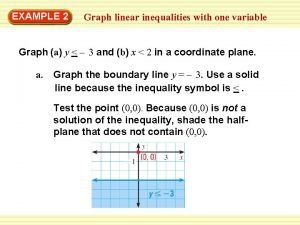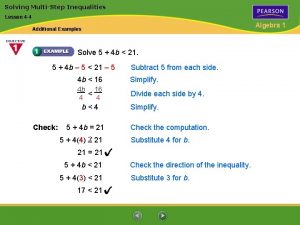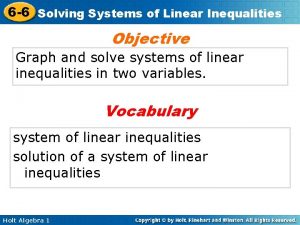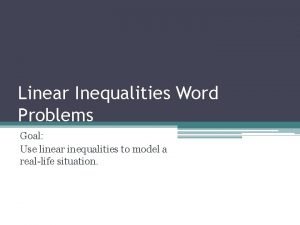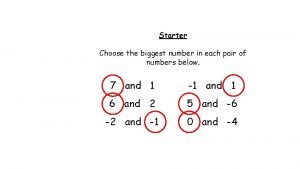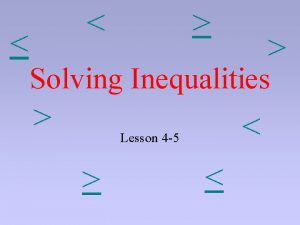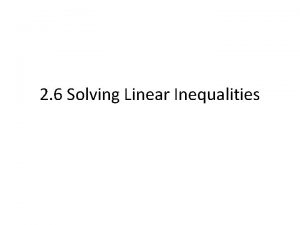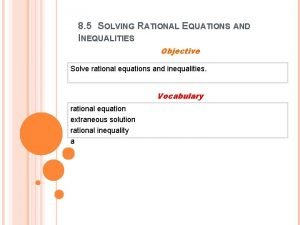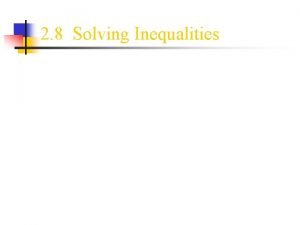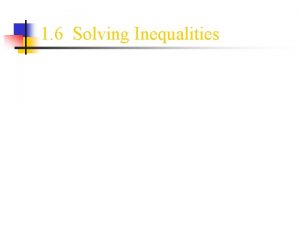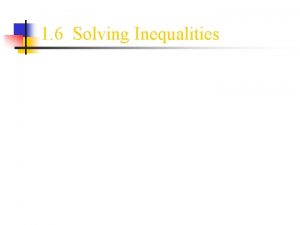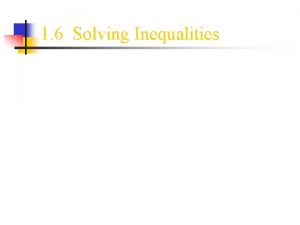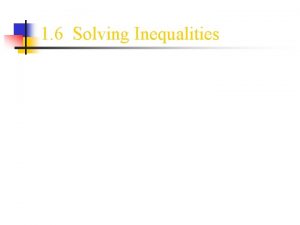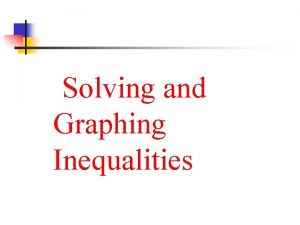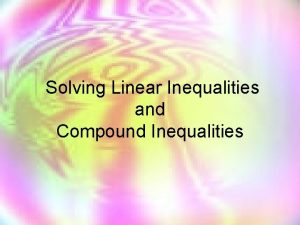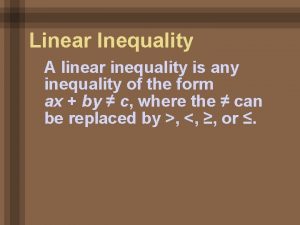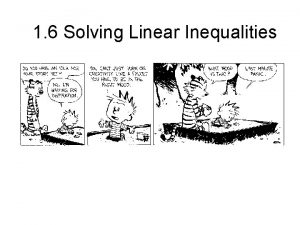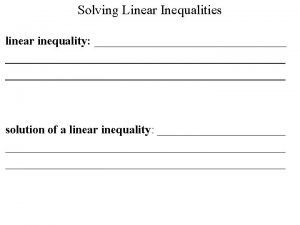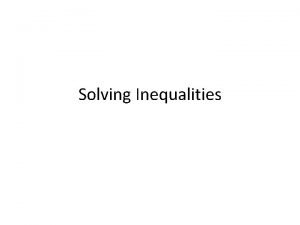6 6 Solving Linear Inequalities A linear inequality





















- Slides: 21

6 -6 Solving Linear Inequalities A linear inequality is similar to a linear equation, but the equal sign is replaced with an inequality symbol. A solution of a linear inequality is any ordered pair that makes the inequality true.

6 -6 Solving Linear Inequalities Additional Example 1 A: Identifying Solutions of Inequalities Tell whether the ordered pair is a solution of the inequality. (– 2, 4); y < 2 x + 1 4 2(– 2) + 1 4 – 4 + 1 4 < – 3 (– 2, 4) is not a solution. Substitute (– 2, 4) for (x, y).

6 -6 Solving Linear Inequalities Additional Example 1 B: Identifying Solutions of Inequalities Tell whether the ordered pair is a solution of the inequality. (3, 1); y > x – 4 y>x− 4 1 3– 4 1> – 1 Substitute (3, 1) for (x, y). (3, 1) is a solution.

6 -6 Solving Linear Inequalities A linear inequality describes a region of a coordinate plane called a half-plane. All points in the half-plane region are solutions of the linear inequality. The boundary line of the region is the graph of the related equation.

6 -6 Solving Linear Inequalities

6 -6 Solving Linear Inequalities Graphing Linear Inequalities Step 1 Solve the inequality for y (slopeintercept form). Step 2 Graph the boundary line. Use a solid line for ≤ or ≥. Use a dashed line for < or >. Shade the half-plane above the line for y > Step 3 or ≥. Shade the half-plane below the line for y < or y ≤. Check your answer.

6 -6 Solving Linear Inequalities Example 2 A: Graphing Linear Inequalities in Two Variables Graph the solutions of the linear inequality. Check your answer. y 2 x – 3 Step 1 The inequality is already solved for y. Step 2 Graph the boundary line y = 2 x – 3. Use a solid line for . Step 3 The inequality is , so shade below the line.

6 -6 Solving Linear Inequalities Additional Example 2 A Continued Graph the solutions of the linear inequality. Check your answer. y 2 x – 3 Check y 2 x – 3 0 2(0) – 3 0 – 3 Substitute (0, 0) for (x, y) because it is not on the boundary line. A false statement means that the half-plane containing (0, 0) should NOT be shaded. (0, 0) is not one of the solutions, so the graph is shaded correctly.

6 -6 Solving Linear Inequalities Helpful Hint Use the “test point” method shown in Example 2 to check your answers to linear inequalities. The point (0, 0) is a good test point to use if it does not lie on the boundary line. However, this method will check only that your shading is correct. It will not check the boundary line.

6 -6 Solving Linear Inequalities Example 2 B: Graphing Linear Inequalities in Two Variables Graph the solutions of the linear inequality. Check your answer. 5 x + 2 y > – 8 Step 1 Solve the inequality for y. 5 x + 2 y > – 8 – 5 x 2 y > – 5 x – 8 y> x– 4 Step 2 Graph the boundary line y = dashed line for >. x – 4. Use a

6 -6 Solving Linear Inequalities Additional Example 2 B Continued Graph the solutions of the linear inequality. Check your answer. 5 x + 2 y > – 8 Step 3 The inequality is >, so shade above the line.

6 -6 Solving Linear Inequalities Additional Example 2 B Continued Graph the solutions of the linear inequality. Check your answer. 5 x + 2 y > – 8 Check Substitute ( 0, 0) y> x– 4 for (x, y) because it is not on the 0 (0) – 4 boundary line. 0 – 4 The point (0, 0) 0 > – 4 satisfies the inequality, so the graph is correctly shaded.

6 -6 Solving Linear Inequalities Example 2 C: Graphing Linear Inequalities in two Variables Graph the solutions of the linear inequality. Check your answer. 4 x – y + 2 ≤ 0 Step 1 Solve the inequality for y. 4 x – y + 2 ≤ 0 –y ≤ – 4 x – 2 – 1 y ≥ 4 x + 2 Step 2 Graph the boundary line y = 4 x + 2. Use a solid line for ≥.

6 -6 Solving Linear Inequalities Additional Example 2 C Continued Graph the solutions of the linear inequality. Check your answer. Step 3 The inequality is ≥, so shade above the line.

6 -6 Solving Linear Inequalities Additional Example 2 C Continued Check y ≥ 4 x + 2 3 4(– 3)+ 2 3 – 12 + 2 3 ≥ – 10 Substitute ( – 3, 3) for (x, y) because it is not on the boundary line. The point (– 3, 3) satisfies the inequality, so the graph is correctly shaded.

6 -6 Solving Linear Inequalities Additional Example 4 A: Writing an Inequality from a Graph Write an inequality to represent the graph. y-intercept: 1; slope: Write an equation in slopeintercept form. The graph is shaded above a dashed boundary line. Replace = with > to write the inequality

6 -6 Solving Linear Inequalities Additional Example 3 a: Application Ada has at most 285 beads to make jewelry. A necklace requires 40 beads, and a bracelet requires 15 beads. a. Write a linear inequality to describe the situation. Let x represent the number of necklaces and y the number of bracelets. Write an inequality. Use ≤ for “at most. ”

6 -6 Solving Linear Inequalities Additional Example 3 a Continued Necklace beads 40 x plus bracelet beads is at most 285 beads. + 15 y ≤ 285 Solve the inequality for y. 40 x + 15 y ≤ 285 – 40 x Subtract 40 x from 15 y ≤ – 40 x + 285 both sides. Divide both sides by 15.

6 -6 Solving Linear Inequalities Additional Example 3 b b. Graph the solutions. Step 1 Since Ada cannot make a negative amount of jewelry, the system is graphed only in Quadrant I. Graph the boundary line for ≤. = . Use a solid line

6 -6 Solving Linear Inequalities Additional Example 3 b Continued b. Graph the solutions. Step 2 Shade below the line. Ada can only make whole numbers of jewelry. All points on or below the line with whole number coordinates are the different combinations of bracelets and necklaces that Ada can make.

6 -6 Solving Linear Inequalities Additional Example 3 c c. Give two combinations of necklaces and bracelets that Ada could make. Two different combinations of jewelry that Ada could make with 285 beads could be 2 necklaces and 8 bracelets or 5 necklaces and 3 bracelets. (2, 8) (5, 3)
 Inequality subtraction rule
Inequality subtraction rule Solving linear inequalities in one variable
Solving linear inequalities in one variable Lesson 4 - solving linear equations and inequalities
Lesson 4 - solving linear equations and inequalities Solving linear inequalities hangman
Solving linear inequalities hangman 5-5 inequalities involving absolute value
5-5 inequalities involving absolute value 6-6 solving systems of linear inequalities
6-6 solving systems of linear inequalities 2-1 solving linear equations and inequalities
2-1 solving linear equations and inequalities Solving compound inequalities worksheet
Solving compound inequalities worksheet How to solve linear inequalities word problems
How to solve linear inequalities word problems Algebra 2 inequalities
Algebra 2 inequalities Lesson 3 systems of inequalities quiz part 1
Lesson 3 systems of inequalities quiz part 1 Solving linear inequalities hangman answers
Solving linear inequalities hangman answers 1-5 solving inequalities answers
1-5 solving inequalities answers Bounded or unbounded graph
Bounded or unbounded graph Lesson 1-6 solving compound and absolute value inequalities
Lesson 1-6 solving compound and absolute value inequalities Amber is solving the inequality x+6-12 13
Amber is solving the inequality x+6-12 13 Exponential inequality definition
Exponential inequality definition Quadratic inequalities in two variable examples
Quadratic inequalities in two variable examples How to do inequalities with variables on both sides
How to do inequalities with variables on both sides Solving inequalities
Solving inequalities Solving rational equations and inequalities
Solving rational equations and inequalities Practice c solving rational equations and inequalities
Practice c solving rational equations and inequalities

